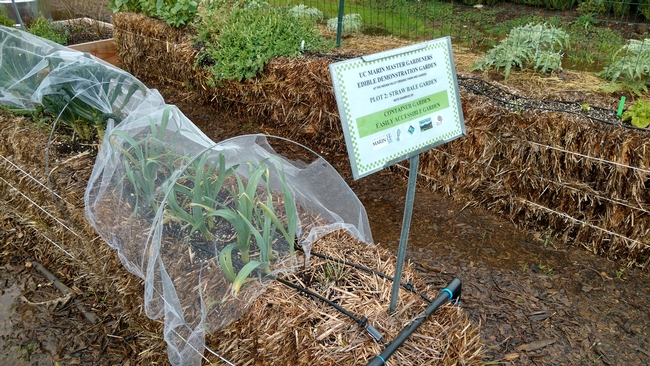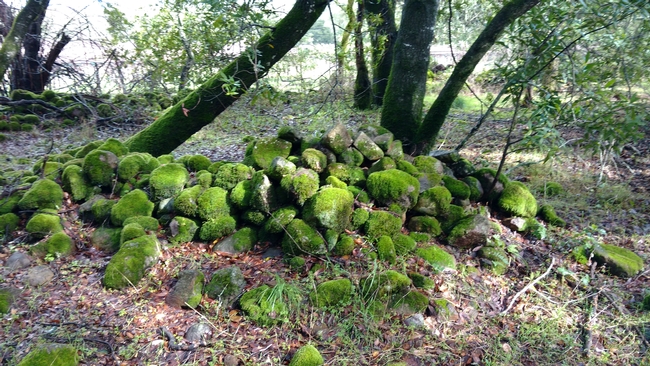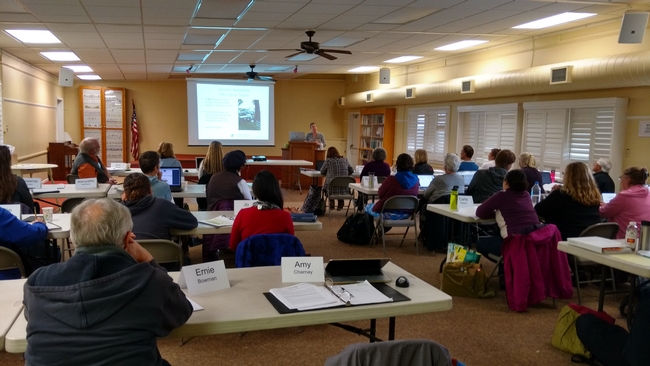- Author: Wendy Powers
I've been thinking more about the after-school 4-H program I watched Diego Mariscal and a few high school volunteers conduct last week in Sonoma County. The kids were learning about the 4 forces of flight (lift, gravity, thrust and drag) and finished it off with a paper airplane competition to see whose would fly the furthest. We left before the final tally but it was interesting to note that despite the obvious lift disadvantage, the smallest participant, a very quiet girl, was in the lead. I was reminded of the last time I was with a group of people making paper airplanes (adults, several of whom were engineers). The group was instructed that the intent of the exercise was to see who could take a sheet of white photocopy paper and make it fly the furthest. Immediately the participants went about constructing fancy paper airplanes, each trying to enhance thrust and overcome the forces drag and gravity. After the participants threw their planes, the moderator took his piece of paper, wadded it into a ball, and threw it further than even the most aerodynamic of plane-shaped papers had flown. I think between the two events, are were several lessons to be learned.
I hope many are considering the recently released Competitive Grants, High Risk/High Reward Grants, and Opportunity Grants programs that were released last week. We have one more program, yet to be released.

- Author: Wendy Powers
Lisa Fisher and I got out of the office today and not only was it fun, but what started as a rainy day in Davis turned out to be beautiful in Marin and Sonoma Counties. I so appreciate the time everyone took to share their programs with us. Truly inspiring work to say the least! David Lewis hosted us in the Marin County office. It was great to hear about the horticulture programs in the county and meet Tami and Vicki, the local Master Gardener co-Presidents; Lauren Klein, the community garden program director (120 gardens!) who is also active with food policy in the county; Lois, a Sapphire Master Gardener Volunteer that has logged over 5,000 volunteer hours; and Peggy Mathers, who oversees the Garden Walk program that, in partnership with the local water district, has completed over 1400 garden walks through the help of over 120 Master Gardener Volunteers. What an impressive Master Gardener program. Lisa and I had a chance to visit one of the newest Master Gardener projects – the edible demonstration garden at Indian Valley Organic Farm and Garden. I never would have thought of using a hay bale as a container garden – how creative and cute! And the partnership at Indian Valley Organic Farm and Garden is a fabulous example of what people can accomplish when focused on a common goal. The result is an outstanding resource for the community as well as for the partners.

Steven Swain and Janice Alexander took us through oak woodland and I learned about the different species of oak trees, sudden oak death and its transmission and how the forest health program interacts with programs across UCCE. I was also impressed to learn that Marin County UCCE has a communications and outreach coordinator, Bonnie Nielson. Not to mention the enrollment success that Allison Keaney and Steven Worker have had with the 4H club and after school programs. No doubt all of the programs rely heavily on support from Vicky Jimenez and Ana Medina. Thanks Marin UCCE for the hospitality!

The visit to Sonoma County UCCE was equally fascinating! Stephanie Larson organized a great afternoon to help me better understand and appreciate the strong partnership UCCE has with Sonoma County including the opportunity to meet some of the county staff that are key to the team (Deborah Curle, office manager; Jesenia Mendoza, Diego Mariscal, and Judy Ludovise with the 4-H program). Karen Giovannini, also a county employee, explained the function of an agricultural ombudsman and the work she is doing with Farmer 101 trainings. And UCCE Advisors Lucia Varela and Rhonda Smith filled me in on the wine grape industry in the county; its value and threats as well as their specific research areas to support the industry. And in addition to being the County Director, I had a chance to learn more about the work that Stephanie is doing with ecosystem services and working landscapes. There is so much going on! We had a chance to see some of the programming in action, including the first class of the winter Master Gardener training program that Mimi Enright was leading.

To finish out the day we watched Diego and high school volunteers work with an after-school 4-H program where everyone was learning about the forces of flight before constructing and testing paper airplanes. The 4-Hers were clearly having a great time and it was a blast to observe. Diego and Steve Worker have big plans for the program with a total of 6 clubs soon-to-be underway.
I'm looking forward to my next visit to Marin and Sonoma to see more of UCCE in action in these communities.
- Author: Wendy Powers
It does seem like we just returned from the holiday break but I won't complain about having Monday off earlier this week. The weather was exactly what I envisioned for California ‘winter'. But early Tuesday morning everyone in UC ANR was back at it, hard at work I am sure.
As always there is much going on. Candidates to be interviewed for the Vice Provost – Statewide Programs and Strategic Initiatives are being narrowed down. If you don't already have February 16-17 on your calendar, please mark it down. Those will be the dates that interviews are held. The interviews will be recorded with feedback due sometime the following week. Feedback on the candidates really is important to us in making a decision!
The search committee has finalized its recommendation for the Vice Provost – Cooperative Extension position and I will be working hard to fill that position. In the meantime, Chris Greer has agreed to remain on until June 1st (thanks Chris!). I am hopeful that might even provide a bit of an overlap between Chris and the incoming Vice Provost which would be nice for all affected by the change.
Wednesday (today) was the Town Hall meeting to provide an overview of the UC ANR strategic plan and answer any questions. At one point 177 participants joined the conversation via Zoom and approximately 50 of us were in the Davis UC ANR building. VP Glenda Humiston provided overviews of the goal of the strategic plan, the process used to gather input, and the resulting goals in the plan. The remaining 45 minutes or so of the hour-long meeting was focused on questions. Several questions were related to fundraising (plans and strategies to raise funds, intended uses of the funds). Other questions were around communicating progress on reaching the goals set forth in the plan. This is a great question and one that one of the Strategic Initiative leaders got me thinking about late last week. Somehow we want to be able to share the division's progress on attaining the goals without getting bogged down with details about where we are in the process. Any suggestions?? If you have some, I'd love to hear them! One of the Zoom participants suggested a graphic or visual representation – maybe something like the thermometers that organizations use to show status of fundraising targets? Give this some thought and I will give it some more thought, too.
One of the questions was about the program prioritization process (goal #5). Like pretty much all of the goals, we don't know what the result of this will look like and haven't formulated a plan to go about gathering information and making any decisions needed to reach this goal. This will be a portion of the agenda for a 2-d retreat to take place at the end of the month. As the ‘goal owner' for goal #5, I have to admit that I was perfectly comfortable early on in the strategic plan development process to leave this as a strategy under another goal. But I understand and ‘buy in' now to the idea that this is so important to who we are and the value we bring to California that it makes sense to have this as a stand-alone goal. As I said at the Town Hall, it is a good business practice to review what you do and how you do it. But this is no easy task for such a large organization with some many different programmatic efforts, all of which make a difference in someone's life. And key questions to think about as we undertake the process is what, if any, programming is needed to realize the 2025 Vision and how do those needs align with current efforts? Still a huge task and, as a result, a few of us have met with someone who I think can help all of us work towards answers. Following development of a draft plan at the retreat I intend to share the plan with strategic initiative leaders, statewide program and institute directors and county directors then finalize a process and approach for having these big conversations so that they are inclusive, not overly time-consuming and lead to information that furthers us in our goals. No doubt success will take time and will benefit from the collective brainpower of everyone at UC ANR. I suspect it's one of those things that you get out of it, what you put into it.
Tomorrow and Friday I am off to visit Marin and Sonoma counties and the Hopland REC. I am looking forward to it and here's hoping for a sunny visit! But just in case, I did get a pair of rain boots. These weren't high on my list to pack when I moved to drought-stricken CA back in June but lately it seems the rain boots may just be a good investment.
- Author: Wendy Powers
In spite of a very wet week, work certainly didn't slow down any.
The Strategic Initiative leaders met this week to do some planning and prepare their panels for the UC ANR Competitive Grants Program and discuss ideas to pull initiative contributors together. This is a fun group with great ideas so I like getting a chance to sit with them every now and then and get their feedback on various topics.
Program Council met for a day+ and finalized the call for proposals. Once that call is released, an announcement will be posted in the ANR Update and I will link to that announcement here. Be on the lookout for that next week. In addition to the standard call, we talked about other ways to support extension and research ideas. More information about those ideas will be out soon, too. Program Council also received program overviews from Tom Tomich, about the SARE Program, and Maggi Kelly, about the IGIS Program. There's so much going on in these programs and quite a bit of opportunity for synergy between the two! Hearing all of the enthusiasm from Program Council about supporting the research and extension efforts across the state is a strong motivator to do more, better.
The REC Directors also did some planning this week. Always good to see them and have a chance to hear about what's new and what's on-going at the RECs. It's far more than just tea hedges. The Rec Directors and the Director of the REC system are no doubt committed to increasing research capacity on the RECs and making sure researchers have a good experience when they conduct a project at a REC. A real bonus for the days was congratulating Dr. Bob Hutmacher, center director for the West Side REC on his recent recognition as the 2017 Cotton Specialist of the Year – way to go Bob!
On Tuesday the UC ANR strategic plan was released and is available from the ANR Update. Time to start tackling those goals! Be sure to tune into the Town Hall meeting on January 18th to ask any questions you might have. You can attend in person at the Davis ANR building or participate via Zoom. The ANR Update provides the time and the Zoom link (click on the date/time to be taken to the Zoom room).
My career in academia and Extension has opened up so many doors to opportunities I couldn't have imagined. I think one more opened this week. I was invited to be a mentor for one of the finalist groups in the UC Berkeley Big Ideas contest! I am so flattered and excited because, yes, this finalist team from UC Santa Barbara wants to talk about manure - right up my alley! Of course I agreed. We haven't met yet but I expect I will learn a whole host of new things from this team of innovation enthusiasts who, like me, see tremendous value in manure. A colleague and I have always talked about taking a joint sabbatical to travel the world and write a book on what we know best. Our plan was to title the book “Exotic Species and Their Feces”. You never know, we might have some emerging co-authors.
In the meantime, stay dry and enjoy our extended weekend to honor a man with big ideas and big words!
- Author: Wendy Powers
Happy New Year and welcome to my blog!
One of my goals for 2017 is to continue to learn all I can about UC ANR, the work we are doing and the impact that work has across California and share it with you through this blog. I will share, also, some of the things going on within UC ANR leadership. If you have something you would like me to know and potentially have shared in the blog, please forward to me.
I don't know about you but, even after a great holiday break with family and friends, I was eager to get back to work. It started with a day-long meeting of the Vice President's (VP) Council. Among the several topics covered was the next step for the strategic plan. The final plan was turned in to President Napolitano right before the holiday break and will be available more broadly within the next couple of weeks. VP Council discussed ideas for developing action plans around each of the 15 goals. VP Council members had some great ideas, many of which will be acted upon when a 23-member group meets January 30-31 to flesh out action steps for at least 5 of the goals. That group includes UC ANR leadership and representatives of the statewide programs, strategic initiatives, county directors, REC directors, UCCE specialists, AES faculty, campus administration, Academic Assembly, Staff Assembly, and UC ANR support units. It's a group that represents a wide array of vested interests in UC ANR. I am looking forward to the interactions and ideas that result.
Members of the VP Council gave updates on their statewide programs and/or business units. I am amazed at all of the exciting things going on and I am sure that, with only 6 months into the position, I know only a tiny piece of the work going on! For example, I had no idea there was interest in growing tea in the Central Valley (past or present) but according to Jeff Dahlberg there is renewed interest and opportunity at the Kearney REC. Clearly I have much to learn and look forward to getting out in the state more in 2017.
Well that's about it for the first day in the office in 2017. Next week Program Council meets to talk about the pending release of the request for proposal submissions to the UC ANR grants program. I hope your 2017 is off to a good start. Please check back often for updates or subscribe to my blog, ANR Adventures.





